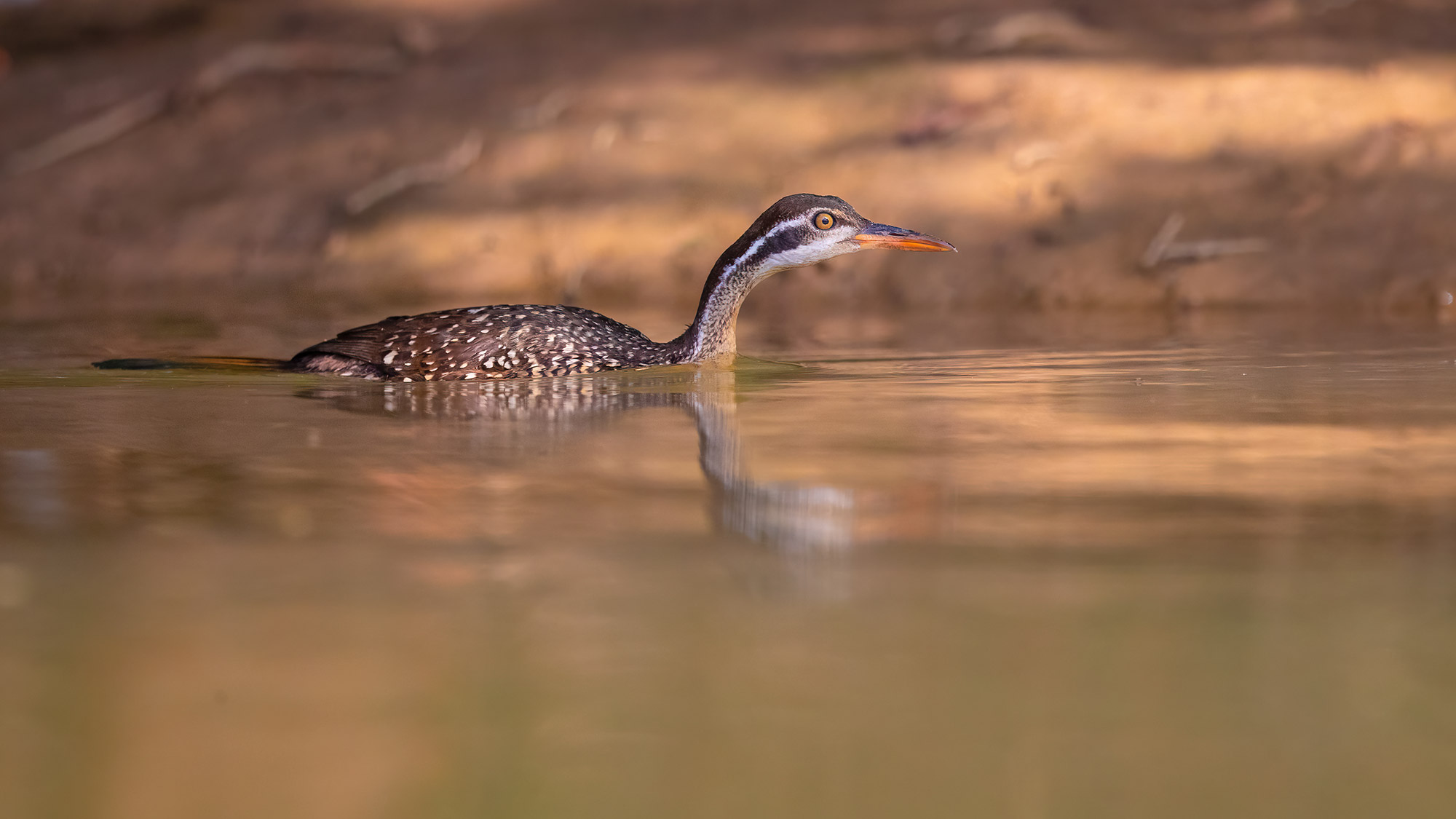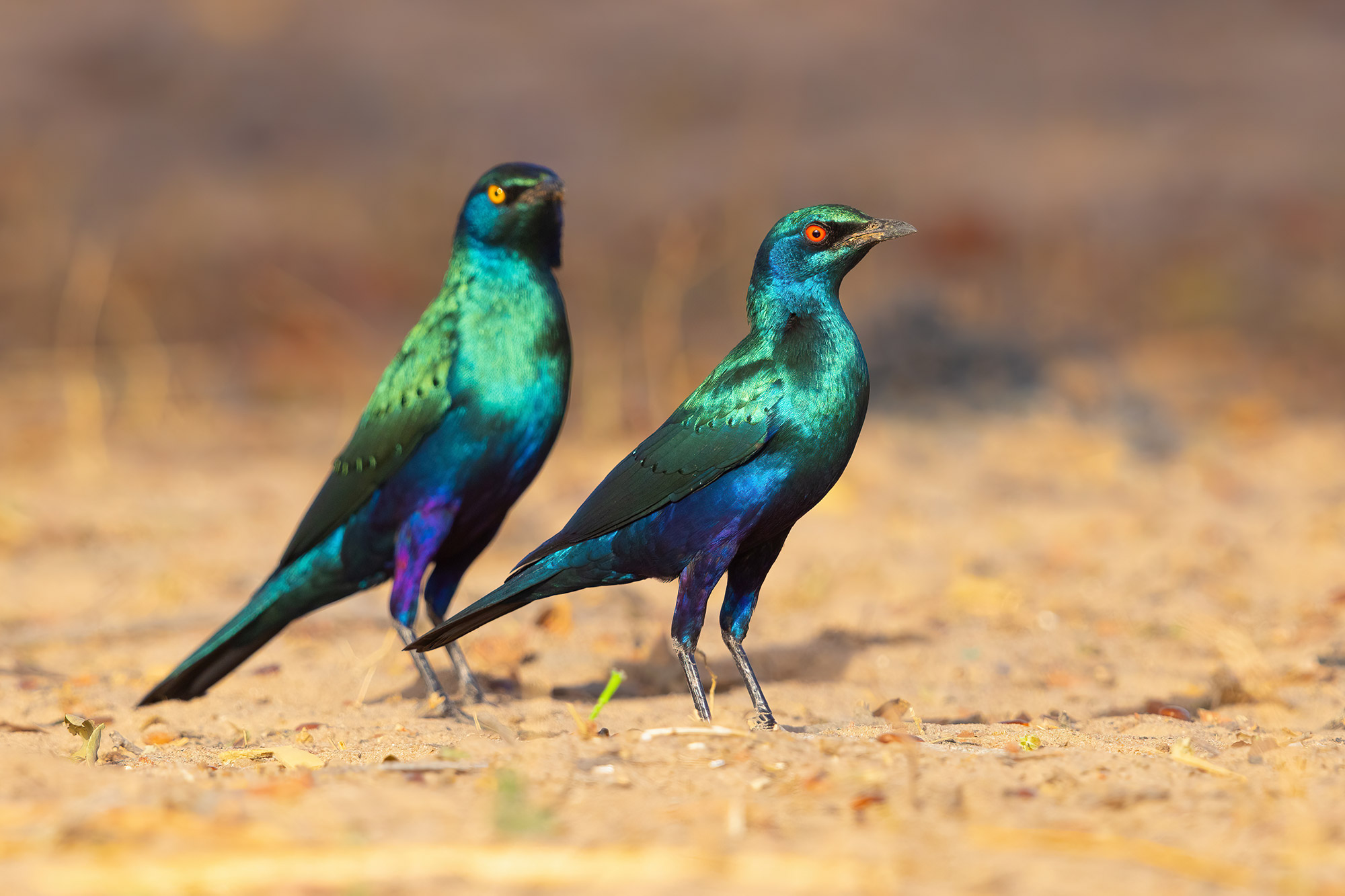The Gambia has long been a popular destination for visiting birders from Europe and further afield, offering an impressive range of sub-Saharan species in a relatively accessible and affordable destination. From the UK, it is just a six-hour direct flight away and has no time difference. It is served by a number of package-tour operators offering good-value winter sun at the resorts on the 'smiling coast' of Africa.
The peak time for tourism coincides with the early part of the dry season (mainly November to February), which is an excellent time for birding in the region. English is widely spoken, infrastructure has improved greatly and there are plenty of good local bird guides available to show you around. Seeing upwards of 250 species is possible in a week to 10 days of intensive birding.

Malachite Kingfisher is one of several kingfisher species to afford stunning views along the River Gambia (Kit Day).
Less commonly visited by birders is The Gambia's sole neighbour, Senegal. This situation has been changing in recent years, with a number of much sought-after species found in the north and east of the country. The improved road infrastructure in The Gambia has made reaching eastern Senegal from the coastal resorts much quicker and easier, while a bridge across the River Gambia at Farafenni has also improved accessibility to the north. With travel opening up, I made my third trip to the region in early 2022 with fellow Suffolk-based photographer Bill Baston, spicing up parts of the classic Gambia itinerary with the addition of a four-night foray across the border into Senegal.
Coastal delights
The coastal birding hot-spots of The Gambia are well-known, and despite the local human population having exploded since my first visit in 2008 (with the inevitable encroachment on habitat), the area is still wonderfully 'birdy'. You could rack up a pretty impressive list simply by relaxing on Kotu Bridge for the day. Four species of kingfisher – Giant, Blue-breasted, Malachite and hordes of Pied – were often in view at the same time from this spot.
Three species of roller frequent the area; Blue-bellied often sit on wires or at the tops of palm trees, parties of Broad-billed hawk insects overhead and Abyssinian will perch on low bushes and at times seem almost oblivious to people. This area is also good for Little and Blue-cheeked Bee-eaters, umpteen waders (including Greater Painted-snipe and many more familiar Palearctic migrants) and herons, Western Red-billed, African Grey and African Pied Hornbills, Yellow-crowned Gonolek, Oriole Warbler, African Golden Oriole, woodpeckers (including the scarce Golden-tailed Woodpecker), sunbirds, raptors, shrikes, barbets, glossy starlings, weavers, estrildids ... the site's list goes on past 300 species.

One of the River Gambia's most iconic species, Egyptian Plover, can be wonderfully confiding when encountered (Kit Day).
I've always found boats and canoes to be a productive method of birding in general, and for photography in particular – birds are often far more tolerant of an approaching boat than they would be of a person on foot. With Kotu Creek and the River Gambia the focal point of much of the wildlife activity here, it makes sense to do plenty of birding and photography from the comfort of a boat here too.
Canoe trips are possible on Kotu Creek, where some of the Western Reef Herons and Reed Cormorants have learnt that a passing boat will push fish to the edge of the creek, so the birds actually plop down into the water just a few metres away in order to hunt. Even a Black Heron seemed to have caught on to this tactic, following the shore parallel to our boat and frequently deploying its unique 'umbrella' feeding method just a few metres away.
Further south along the coast, Kartong also boasts a list in excess of 300 species – African Swamphen, Yellow-billed Oxpecker and an astonishing density of Ospreys being a few of the highlights on our visit – while the small remaining pockets of forest at sites such as Abuko, Brufut, Tanji and Farasutu still hold a good range of species adapted to these wooded habitats. Local guides have set up drinking pools at many of these sites, offering excellent views of species that otherwise prefer to lurk deep inside the dark forest – these include Spotted and Lesser Honeyguides and Guinea and Violet Turacos among others.

The enigmatic African Finfoot can be seen upriver along the River Gambia (Kit Day).
At Brufut and Farasutu in particular, guides have also located roosting nocturnal species including Long-tailed and Standard-winged Nightjars, Pearl-spotted Owlet, Greyish and Verreaux's Eagle-Owls, and African Wood Owl and Northern White-faced Owls. The woodland and scrub at Tujering produced quality birds in the form of Yellow Penduline Tit, White-fronted Black Chat and Chestnut-bellied Starling.
Regrettably, encroaching development in the area may see the end of this site as a birding hot-spot – a fate that has already befallen a large chunk of the forest along the coast at Bijilo, where a vast international conference centre has recently been built.
Heading upriver
Many visitors go home satisfied with plenty of wonderful birding memories having remained on the coast of The Gambia. But for the birder wanting a more authentic African experience, not to mention a host of species unlikely to occur on the coast, going 'upriver' – further inland up the River Gambia – is essential. On my first visit in 2008, this was a real adventure involving many hours of bouncing along the red, dusty and unpaved South Bank Road, but the entire route is now fully tarmacked. While access is now much better, this still feels like the 'real' rural Africa. Some savanna species are much more common upriver; at times there seems to be an Abyssinian Roller by the roadside every few hundred metres!

The mesmerising camouflage of Long-tailed Nightjar makes it tricky to find (Kit Day).
A boat tour of the creeks ('bolons') at Tendaba again proved reliable for the iconic Goliath Heron and African Fish Eagle, as well as a range of kingfishers, herons, storks and more. A Pel's Fishing Owl was seen a day or two before we arrived and African Finfoot is also possible. A cruise downriver from Georgetown also offers the chance of many of these species.
But the pinnacle of our boat-birding experiences on this trip were to be found across the border in Senegal, on the edge of the vast Niokolo-Koba National Park. Here, the River Gambia is much narrower and shallow in places, with muddy banks and gravel islands. While this is great news for birding, it did mean that at times the channel was blocked by the resident family of Hippopotamuses – not an animal you want to get on the wrong side of. If you can sneak past the hippos, however, the rewards are certainly worthwhile.

The highly prized Northern Carmine Bee-eater (Kit Day).
One of the star birds of the region, the exquisite Egyptian Plover, is found here in good numbers and is available later into the dry season than in The Gambia. We saw at least half a dozen, sometimes strutting around at very close range. Northern Carmine Bee-eater – one of eight bee-eater species possible in the region – has become less reliable in The Gambia in recent years but is more numerous in this part of Senegal and one evening a flock of around 100 were perched in riverside bushes and dipping into the water around the boat to bathe. Magical! Other species present that are tricky to see in The Gambia included African Pied Wagtail, White-crowned Lapwing and the poorly known Adamawa Turtle Dove. African Finfoot is also remarkably easy here, Red-throated Bee-eaters breed in the riverbank and there is of course the usual proliferation of kingfishers, herons, raptors, starlings and more.

Senegal’s Niokolo-Koba National Park, the River Gambia offers great birds including Adamawa Turtle Dove and African Finfoot – but beware the hippos! (Kit Day).
Big game and brilliant birds
Niokolo-Koba National Park itself is home to the region's last remaining populations of large mammals, including a few Lions. Much of the park is well wooded and birding here can be quite hard work when you're largely restricted to operating from a jeep, but we did see Saddle-billed Stork (rare in Senegambia) and the mighty Abyssinian Ground Hornbill seemed to be particularly numerous. Time spent birding on foot in the woodlands outside the national park boundary may well prove rewarding.
The final stop on our Senegalese tour was for the sensational Scissor-tailed Kite. This is a sparsely distributed species with few Gambian records, but the discovery of a roost of hundreds or even thousands of birds just a couple of hours from the border near the city of Kaolack has made it much easier to catch up with. In keeping with the theme on this trip, a short canoe ride was involved in getting across to the island on which the birds roost.

From a distance, a bare tree appeared to show unusual grey foliage but a closer approach revealed the 'leaves' to in fact be hundreds of exquisite Scissor-tailed Kites (Kit Day).
On my visit the light was dreadful so it was impossible to capture images of the kites in their wonderful graceful flight, but the views were excellent. The island also hosts an impressive roost of Lesser Kestrels, with hundreds of birds visible on the shores of the island as dusk approached. From here you can also head further north into Senegal to the internationally important Djoudj wetland, as well as search for a range of Sahelian specialities, including Golden Nightjar, Cricket Warbler, Sennar Penduline Tit and Little Grey Woodpecker. Maybe another time!
In The Gambia in particular, the complete loss of tourism for two seasons due to the COVID-19 pandemic has had a major impact on people's lives, with local bird guides being among those acutely affected. Many are also vocal conservationists that are desperately needed in a country whose population has doubled in less than 25 years, with the result that pressure on habitat has subsequently increased.

Lesser Blue-eared Starlings (front right) and Greater Blue-eared Starlings were two of several spectacular starling species regularly seen (Kit Day).
The range of species in this part of the world – many of which are colourful, conspicuous, co-operative and common – is an absolute joy. The opportunity to add Senegal to the itinerary brings an exciting extra dimension, even for veterans of The Gambia. When it comes to 'bang for your birding buck', Senegambia is hard to beat.

Even the common and widespread birds of The Gambia and Senegal tend to be charismatic and colourful. These are Yellow-billed Oxpeckers, doing what they do best (Kit Day).
- This column first appeared in the November 2022 issue of Birdwatch. To be the first to read the magazine each month, take out a subscription to Birdwatch or Bird News Ultimate.

